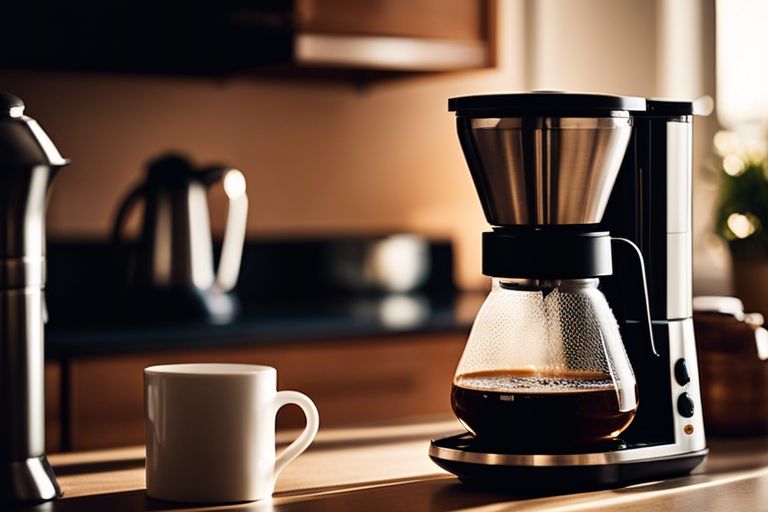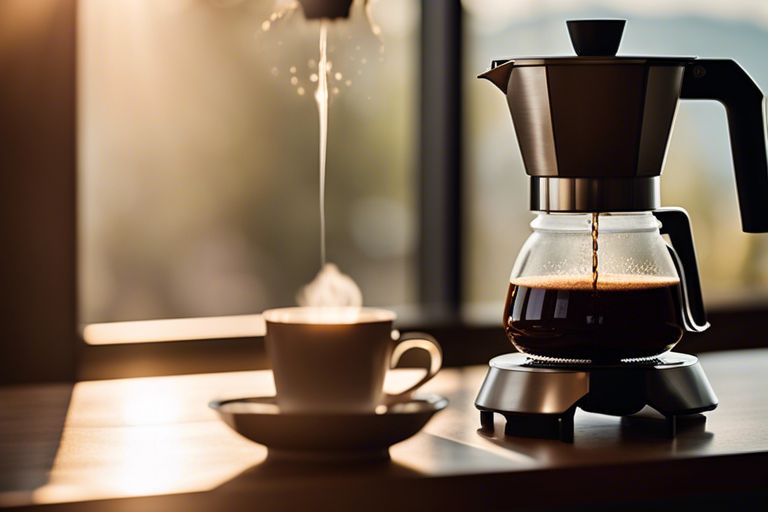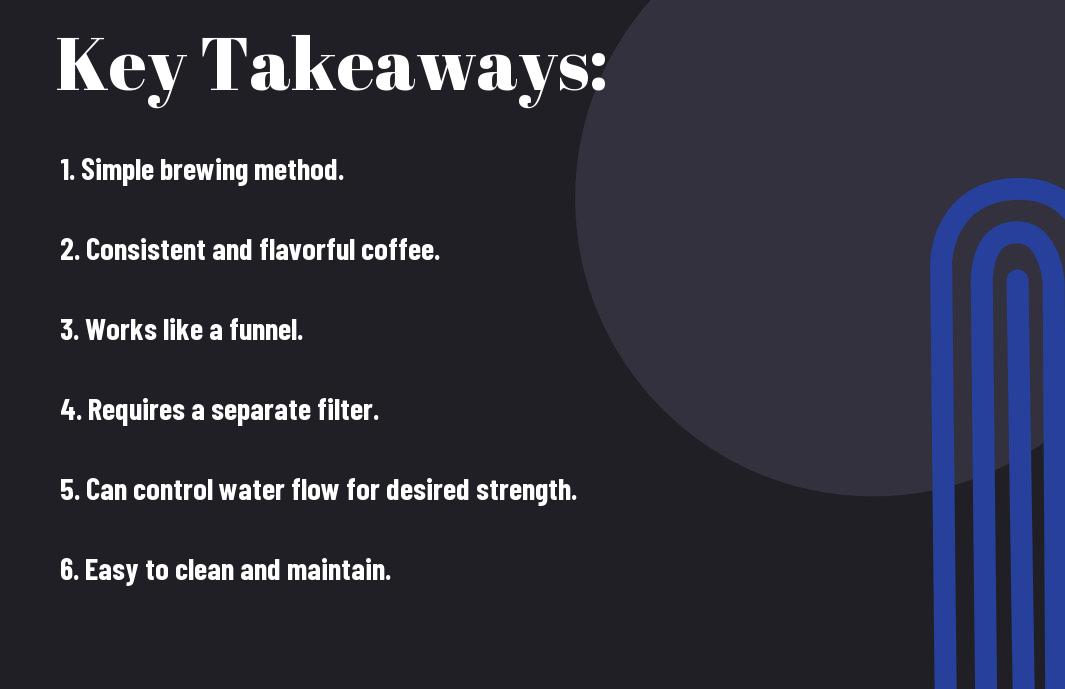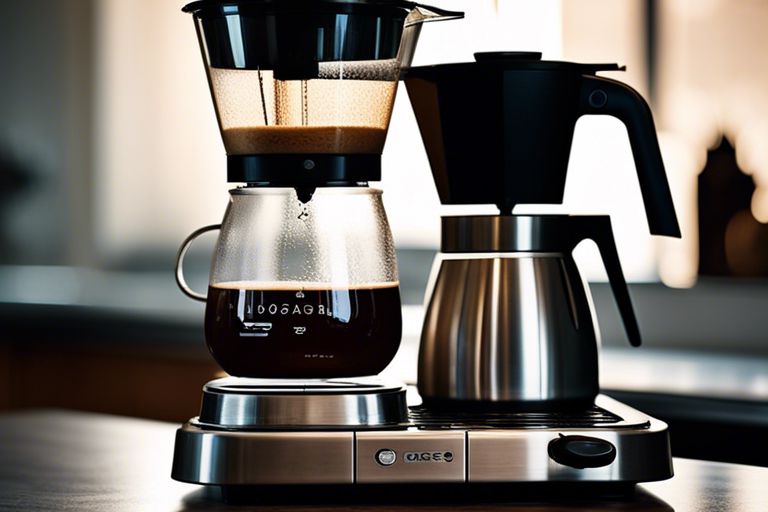You know that feeling when you walk into a coffee shop and are hit with the rich, enticing aroma of freshly brewed coffee? That’s the magic of a pour-over coffee maker at work. This nifty device allows you to have that same cafe-quality experience right in the comfort of your own home. But what exactly is a pour-over coffee maker, and how does it work? Let’s probe the world of pour-over coffee and discover what makes it so special.

Key Takeaways:
- Simple brewing process: Pour-over coffee makers have a straightforward method involving pouring hot water over coffee grounds.
- Customizable strength: Users can adjust the coffee-to-water ratio and pour technique to create a personalized brew strength.
- Enhanced flavor profile: The slow and controlled brewing process of pour-over coffee makers extracts more flavors from the coffee grounds.
- Easy to clean: Most pour-over coffee makers are easy to disassemble and clean, requiring minimal maintenance.
- Portable and versatile: These coffee makers are compact, making them ideal for home use, travel, or even outdoor adventures.

The Basics
While many coffee enthusiasts are familiar with the pour-over method, some may be wondering, “What is a pour-over coffee maker?” In this guide, we will examine into the basics of this popular brewing technique that has gained a loyal following among coffee connoisseurs.
Definition of Pour-over Coffee Maker
An imperative tool in the coffee lover’s arsenal, a pour-over coffee maker is a simple brewing device that allows hot water to flow evenly through coffee grounds, resulting in a flavorful and aromatic cup of coffee. Unlike automatic drip machines that can sometimes compromise the quality of the brew, pour-over coffee makers offer more control over the brewing process, allowing users to adjust factors like water temperature, pouring technique, and brewing time to achieve the perfect cup.
Origins and History
Coffee has a rich history that dates back centuries, with various brewing methods evolving over time to suit different tastes and preferences. The pour-over brewing technique is believed to have originated in Europe in the early 20th century, gaining popularity for its ability to highlight the nuances of different coffee beans and enhance their flavors.
Coffee lovers around the world have embraced the pour-over method for its simplicity and ability to extract the best qualities from freshly ground coffee beans. With a focus on quality and precision, the pour-over coffee maker has become a staple in many kitchens and coffee shops, where baristas meticulously pour hot water over coffee grounds to create a delicious and aromatic brew.

How it Works
Little known for its simplicity and effectiveness, a pour-over coffee maker operates on a straightforward principle. By manually pouring hot water over coffee grounds in a filter, the brewing process extracts the desired flavors from the beans, resulting in a rich and aromatic cup of coffee.
The Brewing Process
For the brewing process, hot water is poured in a circular motion over the coffee grounds, allowing for even saturation. This method ensures that all the coffee grounds are utilized, leading to a fuller extraction of flavors and aromas. The slow and controlled pouring technique is key to achieving a well-balanced and flavorful brew.
Key Components: Filter, Grinds, and Water
Water temperature is crucial when using a pour-over coffee maker, as it directly impacts the extraction of flavors from the coffee grounds. Ideally, water temperature should be between 195-205°F to ensure proper extraction without scalding the coffee.
This method allows the user to have complete control over the brewing process, from water temperature to the pour rate, resulting in a customized cup of coffee tailored to personal preferences.
Benefits
Once again, the pour-over coffee maker shines through its numerous benefits that make it a favorite among coffee enthusiasts. Let’s explore some of the advantages that this brewing method offers.
Flavor Profile: Clean and Nuanced
One of the primary benefits of using a pour-over coffee maker is the superior flavor profile it produces. The slow and controlled brewing process allows for the extraction of flavors in a way that highlights the clean and nuanced notes of the coffee beans. This method often results in a cup of coffee that showcases the intricate flavors and aromas of the beans, providing a delightful sensory experience for the coffee drinker.
Control and Customization
Profile
This brewing method gives coffee lovers a high level of control and customization over their cup of joe. From choosing the grind size and water temperature to adjusting the pouring technique and brew time, users can tailor the brewing process to suit their preferences perfectly. Whether you prefer a bold and strong brew or a smooth and delicate one, the pour-over coffee maker allows you to experiment and fine-tune the variables to achieve your desired taste profile.
Cost-Effective and Environmentally Friendly
Environmentally
This brewing method is not only favored for its exceptional coffee but also for its cost-effectiveness and environmentally friendly nature. Unlike single-use coffee pods or machines that require disposable filters, the pour-over coffee maker relies on reusable filters and simple brewing equipment that can last for years with proper care. This leads to a reduction in waste production and a more sustainable coffee brewing practice that benefits both your wallet and the environment.
Control
In the final account, the pour-over coffee maker offers a wide range of benefits, from elevating the flavor profile of your coffee to providing control and customization options tailored to your preferences. Moreover, its cost-effective and environmentally friendly features make it a top choice for coffee lovers seeking a premium brewing experience with minimal impact on the planet.
Types of Pour-over Coffee Makers
Keep in mind that pour-over coffee makers come in various types to suit different preferences and needs. Recognizing the differences between them can help you find the perfect one for your coffee brewing routine.
Manual vs. Automatic
Any coffee enthusiast knows that choosing between a manual or automatic pour-over coffee maker is a crucial decision. While manual pour-over devices offer more control over the brewing process, automatic ones are ideal for those looking for convenience and consistency. Consider your brewing style and preferences to determine which type suits you best.
Material Options: Glass, Metal, and Ceramic
Any pour-over coffee maker’s material can significantly impact the brewing process and the taste of your coffee. Glass, metal, and ceramic are commonly used materials, each offering unique benefits. Glass is elegant and allows you to observe the brewing process, while metal provides excellent heat retention. Ceramic is prized for its durability and heat retention properties, making it a popular choice among coffee aficionados.
Another crucial factor to consider when choosing between glass, metal, or ceramic pour-over coffee makers is the ease of cleaning and maintenance. Glass is usually dishwasher-safe and easy to clean, while metal and ceramic may require more careful handling to prevent damage.
Size Matters: From Single-Serve to Large Capacity
Pourover coffee makers come in various sizes, from single-serve options perfect for individuals to large-capacity brewers ideal for gatherings or offices. Consider how much coffee you typically brew at once and the number of people you serve to determine the right size for your needs.
SingleServe It’s necessary to note that the size of the pour-over coffee maker can also affect the brewing time and the flavor profile of your coffee. Larger brewers may require longer brewing times, while single-serve devices offer quicker brewing for those on the go. Choose a size that aligns with your brewing habits and lifestyle for the best coffee experience.
By exploring the different types of pour-over coffee makers and considering factors like manual vs. automatic, material options, and size variations, you can find the perfect brewer to elevate your coffee game. Understanding these distinctions will help you make an informed decision and enhance your coffee brewing experience. Happy brewing!
Tips and Tricks
All pour-over coffee enthusiasts can benefit from some tips and tricks to enhance their brewing experience. Here are some suggestions to improve your pour-over coffee game:
- Use freshly ground coffee beans for the best flavor.
- Experiment with different coffee-to-water ratios to find your perfect balance.
- Pour water slowly and in a circular motion to ensure even saturation of the coffee grounds.
- Invest in a quality burr grinder for consistent grind size.
- Pre-wet the coffee filter to eliminate any paper taste before brewing.
Perceiving the nuances of pour-over brewing can be a delightful journey of discovery, so don’t be afraid to play around with different techniques and variables to find what works best for your palate.
Choosing the Right Coffee Beans
Choosing the right coffee beans is crucial for a flavorful pour-over experience. Opt for freshly roasted beans from a reputable source. Consider your flavor preferences – whether you enjoy bright and fruity notes or prefer a more chocolatey, nutty profile. Experiment with different beans to find your favorite brew.
Grinding and Measuring for Optimal Flavor
Tricks for grinding and measuring your coffee beans can significantly impact the taste of your pour-over coffee. Invest in a burr grinder for a uniform grind size, crucial for even extraction. Measure your coffee and water accurately for consistency in every brew.
Measuring the coffee-to-water ratio precisely can make a noticeable difference in the strength and flavor of your pour-over coffee. Use a digital scale to measure your coffee and water in grams for accuracy and consistency. Finding the right balance will help you achieve a delicious cup every time.
Troubleshooting Common Issues
One common issue that pour-over coffee makers may encounter is inconsistency in flavor. This could be due to uneven pouring technique, improper grind size, or inaccurate measurements. By addressing these factors and fine-tuning your brewing process, you can achieve a more consistent and enjoyable cup of coffee.
Optimal pour-over brewing requires patience and practice. Don’t get discouraged by initial setbacks – instead, use them as learning opportunities to refine your technique and elevate your coffee brewing skills. Experiment, have fun, and savor the journey of perfecting your pour-over coffee craft.

Maintenance and Care
Cleaning and Descaling
One of the most important aspects of maintaining your pour-over coffee maker is regular cleaning and descaling. To clean the coffee maker, disassemble it and wash each component with warm, soapy water. Make sure to rinse thoroughly to remove any soap residue. For descaling, fill the water reservoir with a mixture of water and white vinegar, run a brewing cycle, and then rinse thoroughly with water to remove any vinegar taste.
Storage and Travel Considerations
The key to storing your pour-over coffee maker is ensuring that it is completely dry before putting it away. Store the components separately to prevent any odors or mold growth. When traveling with your pour-over coffee maker, consider investing in a protective case or bag to prevent any damage during transit.
The pour-over coffee maker is a delicate tool that requires careful handling, especially when on the go. To protect it from bumps and scratches, consider wrapping it in a cloth or towel before storing it in your luggage.
Cleaning
Regular cleaning of your pour-over coffee maker is imperative to maintain its performance and prevent any buildup of coffee oils or residue. Make sure to clean the components after each use and let them air dry completely before reassembling the coffee maker. This will help ensure that you always enjoy a fresh, clean cup of coffee.
To wrap up
Hence, a pour-over coffee maker is a simple yet effective brewing method that allows coffee enthusiasts to have more control over the brewing process and ultimately enjoy a flavorful cup of coffee. It may take some practice to master the art of pour-over coffee, but the results are well worth the effort. For those looking to investigate deeper into the world of coffee brewing methods, comparing pour-over and drip coffee could provide further insight. Check out Pour Over vs. Drip Coffee: Which Brewing Method Is Better? for a detailed comparison between these two popular brewing methods.
FAQ
Q: What is a pour-over coffee maker?
A: A pour-over coffee maker is a manual coffee-brewing device that allows you to make a delicious cup of coffee by pouring hot water over coffee grounds. It typically consists of a cone-shaped dripper, a carafe, and a filter. This method of brewing coffee gives you more control over factors such as water temperature, bloom time, and pouring technique, resulting in a flavorful and aromatic cup of coffee.
Q: How does a pour-over coffee maker work?
A: To use a pour-over coffee maker, you simply place a filter in the dripper, add your desired amount of coffee grounds, and then slowly pour hot water over the grounds in a circular motion. The water extracts the flavors and oils from the coffee grounds as it passes through, dripping into the carafe below. This process allows for a fresher and more nuanced flavor profile compared to some automatic drip coffee makers.
Q: What are the benefits of using a pour-over coffee maker?
A: Using a pour-over coffee maker offers several benefits, such as the ability to customize your coffee to your preferences, including the coffee-to-water ratio, water temperature, and pouring technique. This method also allows you to enjoy the ritual of making coffee and savor the aromas as the coffee brews. Additionally, pour-over coffee makers are typically easy to clean and maintain, making them a popular choice for coffee enthusiasts who value quality and craftsmanship.
The Ultimate Guide to Brewing the Perfect Cup of Black Coffee at Home





